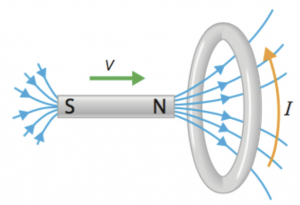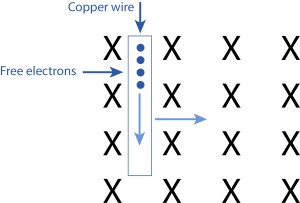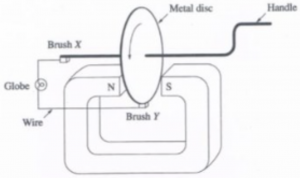Three layers of interpretation to help you conquer Lenz’s Law
Lenz’s law is one of the most challenging concepts in the electromagnetism module of HSC Physics. The majority of students fall into the trap of memorising definitions, however, this will only lead to the misapplication of the concept if the context of the question changes.
In order to understand this concept in depth, I like to consider three layers of interpretation for Lenz’s law:
1. SURFACE INTERPRETATION: Lenz’s law describes the result of a change in magnetic flux.
This is the most common interpretation taught across schools. Definitionally, Lenz’s law states that “a flux change through a conductor will induce an electromotive force (EMF) that opposes this change in flux.” The key thing to understand here is the concept of flux change and distinguishing it from flux. Let’s walk through an example to illustrate this.
Consider the following conductor loop, initially with a magnetic flux of 50 Wb into the page:
 |
 |
 |
| Initial state | If the flux through the loop decreases to 20 Wb into the page, the change in flux is a decrease of 30 Wb of flux into the page. | To oppose this change in flux, we need to INCREASE the flux into the page by 30 Wb (we do NOT create flux out of the page) |
Hence, the induced EMF in the conductor loop increases the flux into the page by 30 Wb – but how does induced EMF create flux?
Induced EMF can create a current if there is a closed circuit; according to the right hand grip rule, the current will induce a magnetic field, which contributes to flux. Hence, in our example above, the induced EMF creates a clockwise current in the loop in order to oppose the flux change.
Let’s look at another example: If the north pole of a magnet approaches a conductor loop, what is the direction of the induced current in the loop?
As the north pole approaches, the flux change is an increase of flux into the loop. Hence, there is a need to decrease flux into the loop, which is the same as creating flux out of the loop. Hence, we need to produce magnetic field out of the loop, and the current produced will be anticlockwise.

2. DEEPER INTERPRETATION: Lenz’s law describes the result of relative motion.
Let’s now look at the concept of flux change more fundamentally. Flux change is essentially a result of the RELATIVE MOTION between the magnetic field and the conductor.
In our example above, the flux change is induced by motion of the magnet approaching the conductor loop. Essentially, to oppose the flux change, we need to oppose the magnet from approaching the conductor loop
For that to happen, the conductor loop must induce a magnetic field to repel the approaching north pole. Hence, the magnetic field created by the loop must point out of the loop in order to repel the approaching magnet, and the current in the loop must therefore be anticlockwise.
Therefore, the fundamental logic of Lenz’s law is that induced EMF in a conductor must oppose the relative motion between the magnetic field and the conductor. In other words, the induced EMF creates a magnetic field, or force, that slows down the relative motion between the magnetic field and the conductor.
From the perspective of energy, as the kinetic energy of the magnet is converted into electrical energy in the form of the induced EMF in the conductor, the relative motion between the two must be slowed as kinetic energy decreases.
3. MICROSCOPIC INTERPRETATION: Lenz’s law is a manifestation of the right hand palm rule.
Another common version of Lenz’s law is that moving conductor induces an EMF in it if it cuts a magnetic field perpendicularly. This is essentially manifestation of the right hand palm rule. Let’s walk this through with an example.
Suppose a conductor rod is moving to the right across a magnetic field into the page, as shown in the diagram below:

The conductor rod is cutting field lines perpendicularly. Let’s look at what is happening microscopically inside the conductor rod.
The particles in the rod are moving along with the rod to the right of the page. The particles are in an external magnetic field that acts into the page. Hence, according to the right hand palm rule, the positive particles in the rod will be forced up the page, and the negative particles will be forced down according to the left hand palm rule.
Hence, positive particles will concentrate on the top of the rod and negative particles will concentrate on the bottom. This creates a potential difference (in other words, a voltage or EMF) between the top and bottom of the rod.
The top of the rod becomes positive and the bottom of the rod becomes negative. The creation of the EMF is a result of the kinetic energy of the rod converting into electrical energy. The creation of the EMF thus will slow down the relative motion between the conductor rod and the magnetic field.
In other words, there will be a force opposing the relative motion between the conductor rod and the magnetic field, and hence opposing the flux change induced by this relative motion. This reasoning is hence the microscopic explanation of Lenz’s law using the right hand palm rule, and we can see it ties well with the previous 2 interpretations.
SUMMARY AND CHALLENGE QUESTION FOR THE BRAVE
Finally, we can tie all of the 3 interpretations together: due to the forces acting on particles in a conductor, Lenz’s law operates and predicts that an EMF will be induced in a conductor to oppose the relative motion between the magnetic field and the conductor (and hence the flux change induced by the relative motion).
Hope this article clears up your understanding of the concept of Lenz’s law and enables you to solve relevant questions across a wide range of scenarios.
For the brave students, here is an interesting question to test what you’ve learned:
Two conductor wires through a sliding contact are set up to touch a rotating copper disc located between the poles of a horseshoe magnet.

Is there a current induced between brush X and brush Y? If so, what type of current and which direction (if applicable)?
Comment your answers below and share with your friends! The first student with the correct answer and working will receive a free session with one of our expert tutors.



Leave a Reply
Want to join the discussion?Feel free to contribute!